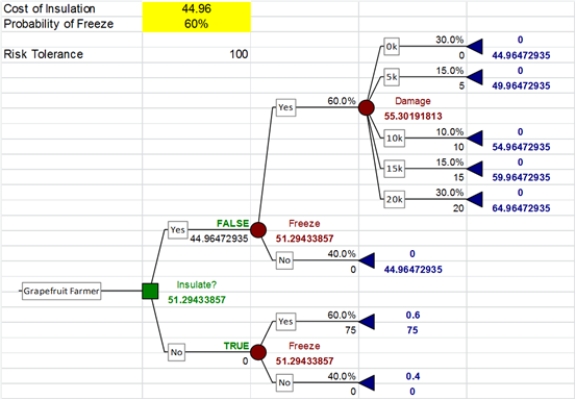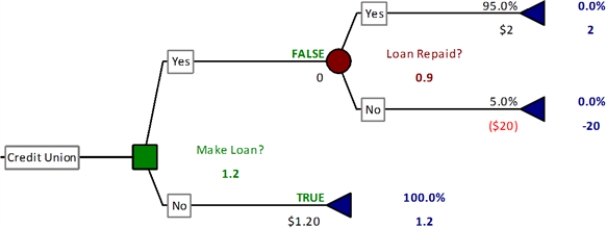Exam 9: Decision Making Under Uncertainty
Exam 1: Introduction to Modeling30 Questions
Exam 2: Introduction to Spreadsheet Modeling30 Questions
Exam 3: Introduction to Optimization Modeling30 Questions
Exam 4: Linear Programming Models31 Questions
Exam 5: Network Models30 Questions
Exam 6: Optimization Models With Integer Variables30 Questions
Exam 7: Nonlinear Optimization Models30 Questions
Exam 8: Evolutionary Solver: An Alternative Optimization Procedure30 Questions
Exam 9: Decision Making Under Uncertainty30 Questions
Exam 10: Introduction to Simulation Modeling30 Questions
Exam 11: Simulation Models30 Questions
Exam 12: Inventory and Supply Chain Models30 Questions
Exam 13: Queuing Models30 Questions
Exam 14: Regression and Forecasting Models30 Questions
Select questions type
For each possible decision and each possible outcome, the payoff table lists the associated monetary value.
Free
(True/False)
4.7/5  (38)
(38)
Correct Answer:
True
Bayes' rule is used for updating the probability of an uncertain outcome after observing the results of a test or study.
Free
(True/False)
4.9/5  (25)
(25)
Correct Answer:
True
Exhibit 9-2A customer has approached a local credit union for a $20,000 1-year loan at a 10% interest rate. If the credit union does not approve the loan application, the $20,000 will be invested in bonds that earn a 6% annual return. Without additional information, the credit union believes that there is a 5% chance that this customer will default on the loan, assuming that the loan is approved. If the customer defaults on the loan, the credit union will lose the $20,000.
 -Refer to Exhibit 9-2. Construct a decision tree to help the credit union decide whether or not to make the loan. Make sure to label all decision and chance nodes and include appropriate costs, payoffs and probabilities.
-Refer to Exhibit 9-2. Construct a decision tree to help the credit union decide whether or not to make the loan. Make sure to label all decision and chance nodes and include appropriate costs, payoffs and probabilities.
Free
(Essay)
4.7/5  (32)
(32)
Correct Answer:

All problems related to decision making under uncertainty have three common elements:
(Multiple Choice)
4.8/5  (34)
(34)
Exhibit 9-1A farmer must decide whether to take protective action to limit damage to his grapefruit crop in the event that the overnight temperature falls to a level well below freezing. If the temperature drops too low he runs the risk of losing his entire crop, valued at $75,000. Based on the National Weather Service, the probability of such a temperature drop is 60%. He can insulate his crop by spraying water on all the trees, which will cost $20,000. This action might succeed in protecting the crop, with the following possible outcomes:
Probability Damage 0.30 \ 0 0.15 \ 5,000 0.10 \ 10,000 0.15 \ 15,000 0.30 \ 20,000
-Refer to Exhibit 9-1. Find the highest cost of insulating the grapefruits for which the farmer prefers to insulate his crop.
(Essay)
4.9/5  (33)
(33)
Exhibit 9-2A customer has approached a local credit union for a $20,000 1-year loan at a 10% interest rate. If the credit union does not approve the loan application, the $20,000 will be invested in bonds that earn a 6% annual return. Without additional information, the credit union believes that there is a 5% chance that this customer will default on the loan, assuming that the loan is approved. If the customer defaults on the loan, the credit union will lose the $20,000.
 -Refer to Exhibit 9-2. The bank can thoroughly investigate the customer's credit record and obtain a favorable or unfavorable recommendation. If the credit report is perfectly reliable, what is the most the credit union should be willing to pay for the report?
-Refer to Exhibit 9-2. The bank can thoroughly investigate the customer's credit record and obtain a favorable or unfavorable recommendation. If the credit report is perfectly reliable, what is the most the credit union should be willing to pay for the report?
(Essay)
4.9/5  (39)
(39)
Exhibit 9-2A customer has approached a local credit union for a $20,000 1-year loan at a 10% interest rate. If the credit union does not approve the loan application, the $20,000 will be invested in bonds that earn a 6% annual return. Without additional information, the credit union believes that there is a 5% chance that this customer will default on the loan, assuming that the loan is approved. If the customer defaults on the loan, the credit union will lose the $20,000.
 -Refer to Exhibit 9-2. Suppose that an actual (not perfectly reliable) credit report has the following characteristics based on historical data; in cases where the customer did not default on the approved loan, the probability of receiving a favorable recommendation on the basis of the credit investigation was 80%, while in cases where the customer defaulted on the approved loan, the probability of receiving a favorable recommendation on the basis of the credit investigation was 25%. Given this information, what are the posterior probabilities that default will and will not occur, given the credit report?
-Refer to Exhibit 9-2. Suppose that an actual (not perfectly reliable) credit report has the following characteristics based on historical data; in cases where the customer did not default on the approved loan, the probability of receiving a favorable recommendation on the basis of the credit investigation was 80%, while in cases where the customer defaulted on the approved loan, the probability of receiving a favorable recommendation on the basis of the credit investigation was 25%. Given this information, what are the posterior probabilities that default will and will not occur, given the credit report?
(Essay)
4.9/5  (44)
(44)
Which of the following statements is true concerning decision tree conventions?
(Multiple Choice)
4.7/5  (48)
(48)
Prior probabilities are sometimes called likelihoods, the probabilities that are influenced by information about the outcome of an earlier uncertainty.
(True/False)
4.9/5  (33)
(33)
In general, the expected monetary value (EMV) of a decision will be equal to one of the possible payoffs.
(True/False)
4.8/5  (28)
(28)
Exhibit 9-1A farmer must decide whether to take protective action to limit damage to his grapefruit crop in the event that the overnight temperature falls to a level well below freezing. If the temperature drops too low he runs the risk of losing his entire crop, valued at $75,000. Based on the National Weather Service, the probability of such a temperature drop is 60%. He can insulate his crop by spraying water on all the trees, which will cost $20,000. This action might succeed in protecting the crop, with the following possible outcomes:
Probability Damage 0.30 \ 0 0.15 \ 5,000 0.10 \ 10,000 0.15 \ 15,000 0.30 \ 20,000
-Refer to Exhibit 9-1. Construct a decision tree to help the farmer make his decision. What should he do? Explain your answer.
(Essay)
4.8/5  (30)
(30)
The strategy region graph is a type of sensitivity analysis chart that:
(Multiple Choice)
4.7/5  (36)
(36)
The solution procedure for solving decision trees is called:
(Multiple Choice)
4.8/5  (33)
(33)
The expected monetary value (EMV) criterion represents the long-run average of uncertain outcomes, so it should only be used for recurring decisions.
(True/False)
4.9/5  (32)
(32)
The risk profile shows the probability distribution of monetary outcomes in both graphical and tabular form.
(True/False)
5.0/5  (34)
(34)
Exhibit 9-2A customer has approached a local credit union for a $20,000 1-year loan at a 10% interest rate. If the credit union does not approve the loan application, the $20,000 will be invested in bonds that earn a 6% annual return. Without additional information, the credit union believes that there is a 5% chance that this customer will default on the loan, assuming that the loan is approved. If the customer defaults on the loan, the credit union will lose the $20,000.
 -Refer to Exhibit 9-2. Should the credit union purchase the report if it costs $150?
-Refer to Exhibit 9-2. Should the credit union purchase the report if it costs $150?
(Essay)
4.8/5  (33)
(33)
For a risk averse decision maker, the certainty equivalent is less than the expected monetary value (EMV).
(True/False)
4.9/5  (26)
(26)
Exhibit 9-1A farmer must decide whether to take protective action to limit damage to his grapefruit crop in the event that the overnight temperature falls to a level well below freezing. If the temperature drops too low he runs the risk of losing his entire crop, valued at $75,000. Based on the National Weather Service, the probability of such a temperature drop is 60%. He can insulate his crop by spraying water on all the trees, which will cost $20,000. This action might succeed in protecting the crop, with the following possible outcomes:
Probability Damage 0.30 \ 0 0.15 \ 5,000 0.10 \ 10,000 0.15 \ 15,000 0.30 \ 20,000
-Refer to Exhibit 9-1. Construct a risk profile and from that determine the probability that no additional cost is incurred if the decision to insulate at a cost of $20,000 is made.
(Essay)
4.9/5  (29)
(29)
Showing 1 - 20 of 30
Filters
- Essay(0)
- Multiple Choice(0)
- Short Answer(0)
- True False(0)
- Matching(0)